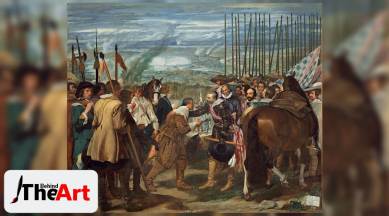📣 For more lifestyle news, click here to join our WhatsApp Channel and also follow us on Instagram
Behind the Art: Velazquez’s The Surrender of Breda: An ode to Spanish military prowess
Behind the Art: 'The Surrender of Breda' is a masterpiece that portrays a crucial moment in the Eighty Years' War between Spain and the Netherlands. Why is it considered a testament to Velázquez's skill as an artist and why does it stand as a lasting legacy in the history of Western art?

In 1625, a momentous event unfolded in Breda as Dutch governor Justinus van Nassau surrendered the city to Spanish General Ambrosio Spínola. This surrender held immense significance in the ongoing war between the Spanish monarchy and the United Provinces of the North. Years later, King Philip IV of Spain asked his court painter Diego Velázquez to create a painting to celebrate the Spanish victory at the siege of Breda. Velázquez knew he had a daunting task ahead of him. He spent countless hours researching the battle, speaking with soldiers who had been there, and studying historical accounts of the event. With his meticulous attention to detail, he brought the momentous event to life on canvas. The Surrender of Breda is a masterpiece that portrays a crucial moment in the Eighty Years’ War between Spain and the Netherlands. Why is The Surrender of Breda a testament to Velázquez’s skill as an artist and why does it stand as a lasting legacy in the history of Western art, admired and studied by art lovers around the world?
Commission and the Aftermath of the Battle
monthly limit of free stories.
with an Express account.
The 1625 event marked an essential milestone in the prolonged war between the Spanish monarchy and the United Provinces of the North due to the city’s strategic importance. The conquest after a long siege was considered an outstanding military achievement, resulting in a flood of texts and images celebrating the victory. To commemorate this victory, the Hall of Realms in the Buen Retiro Palace was decorated with a series of paintings narrating the military triumphs of Philip IV’s reign. Velázquez, the court’s most prestigious painter, was commissioned to paint it. The Surrender of Breda was one of the paintings that adorned the most magnificent room in the palace, which had two important functions: it was a throne room, and it was a place for music and theatrical performances. As such, the Hall of Realms was where emissaries and ambassadors were received and entertained.
Velázquez’s painting depicts the surrender of the Dutch to the Spanish troops, but he chose to remove the bloody and violent aspects of the battle. Instead, he presents the aftermath of the battle, showing the Dutch as disorganised, youthful, and few, while the Spanish troops are presented as a large, well-organised, and seasoned group. The painting’s dimensions, the importance of the event it depicts, and the significance of the hall where it was to hang all encouraged the painter to put his best efforts into this work, offering proof of his extraordinary capabilities.
Moreover, Velázquez’s capacity to place all of a painting’s elements at the service of the specific content is evident in this work, which reveals not only his extraordinary descriptive gifts and mastery of aerial perspective but also his narrative skills. The numerous spears rising vertically over the horizon in the painting create a sense that there are more Spanish troops than we can see, emphasising the military competence of the Spanish soldiers. All in all, The Surrender of Breda is an important painting that showcases Velázquez’s exceptional talent as an artist and his ability to bring history to life through his art. The painting is an important cultural artefact that reflects the political and social realities of its time and continues to resonate with audiences today.
The Debate on the Historical Accuracy of the Painting
While several art critics claim this artwork to be historically accurate, some claim there is not even a single document of this historical event. Thus it is a simple reproduction of the so-called event. Although some elements of the painting accurately reflect the historical event, one should not be misled by Velázquez’s naturalistic style. The Surrender of Breda was not intended to be a faithful reproduction of the event, but rather a carefully constructed scene commemorating Spinola’s generous character. Velázquez has skillfully emphasised Spinola’s figure, complete with a baton of command, splendid armour, and a vivid magenta sash, even though the encounter depicted may not have occurred. Despite the lack of blatant symbols, allegorical figures, or idealised figures, the painting invites viewers to experience the scene as though they were present. The painting captures a moment of humanity amid the chaos and brutality of war. However, the seemingly virtuous moment is not without ulterior motives. The presentation of Spinola, the Spanish troops, and by extension Philip IV, as powerful and honourable serves to rhetorically promote Spanish national identity, symbolise Philip IV and his army, and pay tribute to Spinola, who was a personal friend of Velázquez and had passed away a few years before the commission of the painting.
The Surrender of Breda is a remarkable achievement in the history of art, showcasing Velázquez’s extraordinary skill in portraying a moment of historical significance with a naturalistic style. The painting showcases Velázquez’s artistic technique, including his use of light, shadow, and perspective. It captures the human drama and emotions of war, conveying pride, humility, victory, and defeat. The painting has had a lasting influence on subsequent artists and continues to be admired for its historical significance and artistic brilliance.
Next up in Behind the Art: When Art Meets War: Altdorfer’s Epic Depiction of ‘The Battle of Alexander at Issus’
📣 For more lifestyle news, follow us on Instagram | Twitter | Facebook, and don’t miss out on the latest updates!
📣 For more lifestyle news, click here to join our WhatsApp Channel and also follow us on Instagram